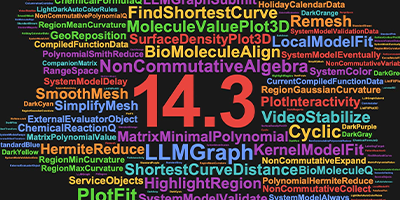Two Hundred Thousand Snowflake Greetings to You and Yours
Take Stephen Wolfram’s theory of the universe, add a dash of symmetry, and what do you get? Snowflakes.
Cellular automata—the basis of Stephen’s theory—typically operate on rectlinear grids. But with suitable automata rules and a simple geometric transformation, you can achieve patterns with six-fold dihedral symmetry, the symmetry of snowflakes.

My colleague Ed Pegg Jr. showed that idea nicely in his Demonstration “Snowflake-Like Patterns”. I started with his Demonstration; added some ideas from Matthew Szudzik’s related Demonstration, “Snowflake Growth”; and fine-tuned the rendering to recall Bentley’s classic snowflake photos, arriving at this interactive snowflake generator.

I haven’t had time this morning to explore all 233,280 snowflakes contained in this little program, but I have discovered that there are some real surprises in there. Like rule 3174, which explodes in snowflake fireworks as you animate the steps from 1 to 64. Or the closed, self-avoiding curves of 3649 and 3313. Or 3516, like an intricate snowflake pattern on a Scandinavian winter sweater.
There are many more gems in there, and you can help find them. If you haven’t done so already, install the Wolfram CDF Player browser plugin so the controls above come to life. Explore the possibilities, and if you find something interesting, send us a comment below with the coordinates of the snowflake, for example, {3313, 51} for rule 3313 at step 51. We’ll append images of the reader-supplied snowflakes to the post. Supply a title too, if you like. My colleague Andrew Moylan christened the initial {2653, 64} snowflake above “Dinner for Six.”
Here are some tips for easier exploring: enter a rule number directly by clicking the “+” icon to the right of the slider and typing in the input field. Press the Alt or Option key while dragging the sliders for fine control, and additionally Shift for even finer control.
From us and ours at Wolfram Research to you and yours, best wishes for the winter holidays. We’ll see you in the new year.
Download this post as a Computable Document Format (CDF) file.
 {1517,54} |
 Fine Web, {2633,64} |
 Dinner for Six, {2653,64} |
 Candy Bowl, {1708,64} |
 {3432,64} |
 Dancing Figures, {3394,57} |
 Dew in Spider Web, {1338,64} |
 Turbine, {946,64} |
 Holding Hands, {1088,64} |
 Harmonic, {349,69} |
 Chandas, {2047,69} |
 Time and Eternity, LI, {3174,58} |



very cool, thanks
The entire rule 1517 and especially {1517,54} seems to be pretty interesting.
{2563,*}: fine web
correction!: {2633,*} fine web
{1708, 64} – “Candy Bowl”
Note the “m” shapes distinctive of M&Ms candies, and the slightly smaller candy hearts. (In black, against a white background.)
Is it possible for a snowflake to have pieces that are not connected? Many flakes have little isolated fragments, not connected to each other.
Stefan — I like the concept: isolated snowflake fragments flying in formation as a single flake. But of course that wouldn’t happen. These automata flakes are graphically suggestive of snowflake forms, but the program doesn’t simulate the accretion processes of actual flakes.
{3432,16-64} is particularly nice.
{3427, *} has a particular blinking effect changing the iteration steps.
There are many very regular sets: {3451,*}, {3448,*}, {3433.*}, {3432,*}, {3421,*}, {3422, *}… there should be a big family of them…
Of a similar kind, its “negative”, is {3429,*}
I enjoyed playing with this set of hexagonal patterns and was quite amused by their remarkable variety. Here are a few configurations I liked.
{3394, 57} – Dancing figures
{1338, 64} – Dew in spider web
{946, 64} – Turbine
{1088, 64} – Holding hands
{126, 82} Stable Isotopes
{349, 69} Harmonic
{919, 73} Primality
{997, 73} Circumvention
{1010, 101} Fibonacci
{1112, 73} Secret Garden
{666, 666} Primes of Pandovan
{2047, 66} Rhythm of Ritual
{2047, 77} Chandas
{2198, 67} Ramanujan Remembered
{2385, 86} Conjecture
{3666, 49} Chromosome
{3803, 110} Pythagorean M2
These patterns are great! Will you pin up { 3174 , 58 } for me? It looks like a sky full of (1/2+3/2+5/2+7/2) 12 = 96 snowflakes falling in a harmonious configuration. Inspiring. I would name this after my favorite poem this winter, Emily Dickinson’s:
“Time and Eternity, LI”
I suspect 233,280 is actually how many possible snowflake combinations there are correct? As 233,280 is the mean distance in miles from the earth to the moon, the numbers have a way of doing that lol.